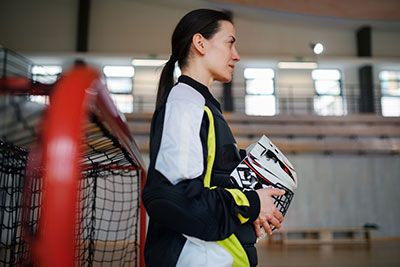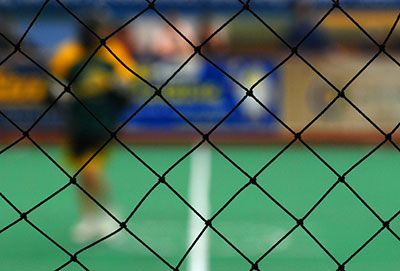If you've heard of box lacrosse but are still determining what it is, our guide is the right for you! You will learn the basics, know the rules and requirements better, and enjoy matches.
Here's the heck: You don't need to be a pro to understand box lacrosse.
So, if you're enthusiastic enough and want to know more about the sport, read the info below to find the answers.
More...
Take Away Key Points:
Refer to the guide below to find all the crucial technicalities to understand the game better.
What is box lacrosse/indoor lacrosse?

Box lacrosse, also known as indoor lacrosse, is a variation of the popular sport played inside, in an enclosed ice-hockey rink or arena. It is a full-contact game with five players plus one goalie (six players in total) per side playing on a small ice hockey-sized rink surface once the ice is covered or removed.
Box lacrosse has many of the same rules and field concepts as a traditional lacrosse field game but is faster-paced and more aggressive. The walls around the indoor rink (the box) keep playing in bounds. So, it has more physical contact between players than allowed on a traditional outdoor lacrosse field.
Box lacrosse also features different rules than those found in traditional games, such as the size of the field, the number of players, and the type of equipment used. Box lacrosse is an exciting game to watch and can be highly competitive for those who play it. It has become a popular sport across North America.
The history of the sport
The origins of box lacrosse can be traced back to the 1920s and 1930s in Canada. It was originally developed as a way to speed up the game.
The ancient origins date back to Native American Reservations as a spiritual healing and cultural identity. Even today, native peoples actively play the game.
A Canadian lacrosse player and referee, Breanna, experimented with the playing area as he was annoyed by the constant delays of the game due to balls going out of the field. So, he created a barrier and made box lacrosse an indoor game.
As the sport evolved, more and more variations of indoor lacrosse began to appear throughout Canada. By the late 1930s, the sport had become a popular pastime in many regions. It was even being played competitively.
The indoor-field game held its first professional matches in 1931 in Canada, to later spread to Australia and worldwide. It was then that the Canadian Lacrosse Association started sponsoring box lacrosse. But, in the 1970s, a new professional lacrosse league was established - National Lacrosse League.
The Eagle Pro Box Lacrosse League was formed in 1986 and played during the winter, untypically for indoor games. Then, the association was known as the Major Indoor Lacrosse League (MILL), to become the NLL in 1998. And this year, the EPBL announced new nine teams for the league.
National Lacrosse League: The main purpose
The National Lacrosse League (NLL) is North America's official men's professional box lacrosse league. Their headquarters are in Philadelphia, Pennsylvania.
The NLL consists of fifteen teams in the USA and Canada, and unlike other box lacrosse leagues, they have seasons from December to June.
The officials are responsible for the box lacrosse rules, play matches, and possible violations of the regulations. They decide suspensions, penalties, and similar "punishments" if teams do not act according to the given standards.
What are box lacrosse rules?

The main rules include the following:
- The sport uses a shot clock
- The attacking team must take a shot on goal within 30 seconds of gaining possession of the ball.
- Players must advance the ball from their own defensive end to the offensive half of the floor within ten seconds (eight seconds in NLL).
However, rules are also tackling the:
1. equipment
2. officials
3. positions
Let's learn them.
1. Equipment
A player's lacrosse stick is 40-46 inches (1.2-1.6 meters) long. Youth lacrosse players use short sticks. Wooden sticks are allowed in most box lacrosse leagues. But, the modern version of the game offers players who prefer aluminum or similar metal with plastic heads. However, the NLL games do not allow wooden sticks at all.
In addition to lacrosse sticks, players must wear protective equipment, such as:
- Lacrosse helmet with a face mask
- Arm and shoulder pads
- Back/kidney pads
Players can also wear rib pads, but these are optional in some leagues. In some leagues, especially the NLL, the five players - runners wear a specific helmet designed for box lacrosse. The helmets are hockey types with a box lacrosse mask attached instead of a hockey cage.
2. Officials
The number of officials also varies from one to three during a specific game, depending on the level of play and the league. Most games will include a minimum of two referees: a lead official and a tribal official. The NLL games consist of three officials per match. Below you can find more about the players' positions.
3. Box lacrosse players & positions
During the game, a team includes six players: a goalie and five runners. The runner can be any position of a non-goalie player - forward/offensive player, transition player, and defensive player. Usually, runners specialize in one of these positions, substituting off the field when the ball moves from one end to another.
Originally, the game played six runners, but in 1953 the position known as the rover was eliminated.
The goalie might be replaced by another runner. Such a rule applies when:
- The delayed penalty is called on the opposing team, or
- At the game's end by the teams that are behind to help score more goals.
Let's explain each position separately.
a. Offending player/attacker
The attacker is an offending player in the offensive area of the rank. The player is dominant by throwing with one hand or another. However, there are some players - who don't pay attention to the side of the rink. Instead, they focus more on the crease area near the goalkeeper.
b. Defensive players
Box lacrosse also has defenders, similar to field lacrosse. The player has the same job as the field lacrosse player - to prevent the opposing team from scoring.
However, a box lacrosse player differs from a field lacrosse defender, as he must use only sticks up to 64 inches long. So, field lacrosse players use longer sticks.
Defensive tactics include the following:
- cross-checking: a player uses the stick's shaft to push the opposition player off balance
- body-checking: a player makes contact with the opposition player's stick to knock the ball loose.
c. Transition players
A transition player is a team member whose main task is to play during defensive situations but with an offensive point of view. He must create scoring opportunities and fast breaks.
d. Goalkeeper
The goaltender's main job is to prevent the opposing team from scoring goals by directly defending the goal and net. Box goalie equipment includes the upper body gear (no more than 3x5 inches out of the shoulder).
The equipment differs from the field lacrosse goalies or ice-hokey goaltenders (it's much larger). The shin guards must be of specific dimensions - 11 x 9 x 7 inches, and the goalkeeper must wear an ice hockey goalie mask or a field lacrosse helmet.
The only goalkeeper can be inside the crease - an area in front of the goal. Similarly to lacrosse, the goalkeeper has privileges while inside the crease. However, if he leaves the area, he loses all the benefits.
Playing area
The playing area of box lacrosse during the summer months is in an ice hockey rank. The playing surface is a concrete floor under the melted ice.
The dimensions of the area include 180-200 feet x 80-90 feet. However, the NLL uses artificial turf placed on top of the ice. Some leagues and their teams have dedicated box lacrosse arenas (Iroquois, for instance) that use artificial turf for the playing area, similar to the NLL.
Traditional dimensions of the box lacrosse goal are 4x4 feet, but in the NLL, the dimensions are larger - 4.9x4 feet. So, the nets are smaller than the lacrosse nets 6x6 feet.
Duration & tie-breaking methods
According to the Canadian Lacrosse Association rules, the match consists of three twenty-minute periods (similar to ice hockey), and the teams change areas after each period is over.
However, the NLL rules dictate four fifteen-minute quarters instead of three periods. And, if the game is a tie, additional five minutes are played. In the NLL, this period is a fifteen-minute extra time.
Ball in & out of the play

After each goal or period, the game stops with the face-off. If a ball ends up outside the playing area or travels overboard, the game starts over, and the possession is in the opposing team's hands if they were last to touch the ball.
During the play, teams can substitute their players in or out freely. It refers to the on-the-fly substitution, which must be done in the determined exchange area in front of the player's bench. Otherwise, it won't be legal.
A minor or major penalty
For most penalties, the offending player is sent to the penalty box, and his team must play without him and with one less player for a short period.
Minor penalties usually last for two minutes unless they are major penalties. The team taking the penalty is playing shorthanded, while the other team is in power-play mode.
A two-minute minor penalty is often called if there are smaller inconveniences, such as tripping, slashing, roughing, elbowing, too many players, interference, holding, or illegal equipment.
A five-minute-major penalty occurs due to more violent behavior and unfair play, like an injury to the opponent or fighting.
Players are released from the penalty box only when the penalty time expires or the opposing team scores a goal (or three goals during the major penalty).
The referee might also seek a ten-minute misconduct penalty. The player serves the full time of the penalty, but the team might substitute the penalized player immediately. However, if the referee seeks minor or major penalties due to misconduct, the substitution players are not allowed.
The team might determine another player to go in the penalty box and serve a major or minor. Both players are in the box, but only the designee cannot go out - he is free after the two or five minutes expire.
If misconduct is a major issue, the misconduct is assessed for deliberate intention to cause severe injury to the opponent. A player who receives the misconduct leaves the game and might not return. And receiving two major penalties in the match jeopardizes the misconduct.
Under specific circumstances, a referee might assess the non-offending team with a penalty shot. The non-offending player shoots the ball, and only the goalkeeper defends the goal. No other players are protecting the net.
To achieve this, teams must have a minimum of three runners in the game. If a team commits the third penalty resulting in a three-men-down situation, the penalty occurs in favor of having the offending player serving in the penalty box.
A referee can seek a penalty shot if a defensive player causes a foul to prevent shooting (tripping, holding, deliberately displacing the goal, or throwing the stick). A defender might also fall and cover a ball in his own team's crease part.
In the NLL, the officials assess a penalty shot against any team if they take a too-many-men penalty in the final two minutes of the game or the overtime.
Fighting
Fighting is tolerable in box lacrosse up to some extent. The same rule applies to hockey. Players are not immediately thrown out of the game, yet they can deserve a minor or major penalty, plus a game misconduct.
Fighting in club level or youth box lacrosse penalizes with suspensions or expulsion. Fighting was particularly unacceptable during the 1990s when the Six Nations created the new Mohawk Lacrosse League. Misconductors were ejected, suspended, and could not participate in a minimum of three matches.
International box lacrosse competition
Box lacrosse is the most popular in the Czech Republic. It has its traces in Australia as well. However, it's the most dominant game in the USA, with:
- Metro Area Box Lacrosse League
- Philadelphia Box Lacrosse Association
- Baltimore Indoor Lacrosse League.
The first box lacrosse world championship took place in Canada in 1980 and included national teams from the USA, Iroquois Nationals, Australia, and Canada.
The second world lacrosse championship took place in 2003, and teams from the Czech Republic, Scotland, Australia, the US, Canada, and Iroquois Nationals could compete internationally.
The 2015 World Indoor Lacrosse Championship was held by Onondaga Nation, making box lacrosse the only sport being held on indigenous land. Among the "domestic" box lacrosse teams, Switzerland, Turkey, Ireland, Israel, Finland, Germany, and Serbia found their places.
Other international tournaments include the Aleš Hřebeský Memorial tournament in Prague - the biggest one in Europe, and the Heritage Cup played by the Americans and Canadians.
Women's box lacrosse
The primary version of box lacrosse included only men, and women played the field lacrosse version. However, nowadays, the Canadian provinces of British Columbia, Nova Scotia, Alberta, and Ontario established women's box lacrosse.
Of course, Ginny Capicchioni was the first woman ever to appear in the National Lacrosse League in 2003.
FAQs
How hard is box lacrosse?
It's harder than traditional lacrosse, as players are confined inside the box, and have only thirty seconds for shots. In addition, fighting is allowed, and the amounts of shots are greater than in outdoor lacrosse. The players cannot stand around.
Why do box lacrosse players not switch hands?

Players do not switch hands as they rely on passing and the movement of their teammates to move the ball across the floor. Unlike in outdoor lacrosse, they don't spread out the defense and dodge from a certain distance. Thus, the need for “two hands” in box lacrosse is almost useless.
Why are box lacrosse helmets different?
The helmets are different as they are lighter with a specific face-masking. They are shaped smaller around the head and increase the player's vision since they are "trapped" in a restricted area during the play.
How do you get in shape for box lacrosse?
The three most successful exercises include:
- Doing hill sprints
- Much basketball play
- Lunges around the track
What are the age groups for box lacrosse?
According to the North Shore Minor Lacrosse, there are several age groups in box lacrosse, including:
- MINI-TYKE (aged 5 and 6)
- TYKE DIVISION (aged 7 and 8)
- NOVICE (aged 9 & 10)
- PEEWEE (aged 11 and 12)
- BANTAM (aged 13 and 14)
- MIDGET (aged 15 and 16)
What do the lines mean in box lacrosse?
Restraining lines are eleven feet from the center of the floor in each direction. The Center Zone is marked as the floor area between these two lines. The two areas outside these lines are known as Offensive Zones.
Final Words
Box lacrosse is a popular sport becoming valuable in various countries worldwide. It is a fast-paced game with unique rules and regulations that distinguish it from traditional outdoor lacrosse.
The game also promotes physical fitness as players must constantly be active and continuously move to keep up with the quick pace of the game. With its growing international presence, box lacrosse is an exciting sport to watch and play.
